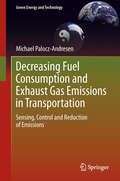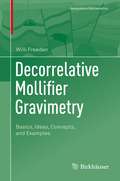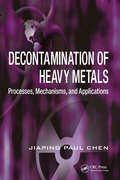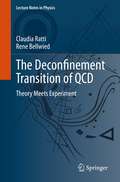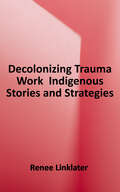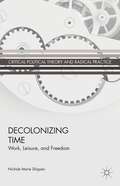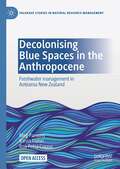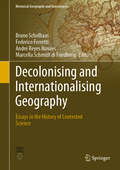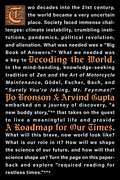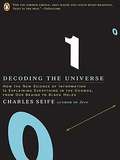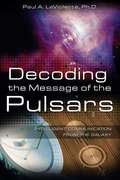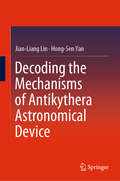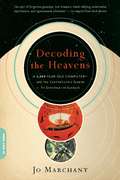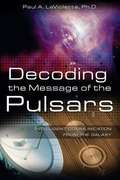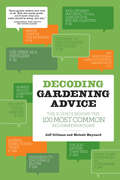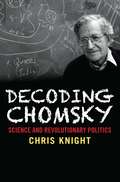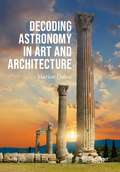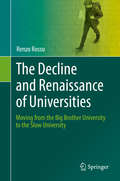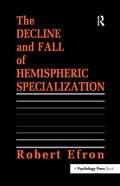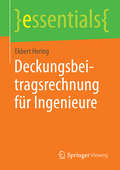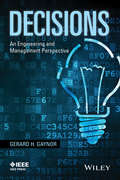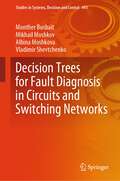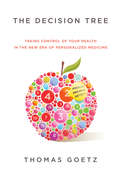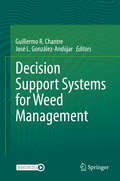- Table View
- List View
Decreasing Fuel Consumption and Exhaust Gas Emissions in Transportation: Sensing, Control and Reduction of Emissions
by Michael Palocz-AndresenWithin all areas of transportation, solutions for economical and environmentally friendly technology are being examined. Fuel consumption, combustion processes, control and limitation of pollutants in the exhaust gas are technological problems, for which guidelines like 98/69/EC and 99/96 determine the processes for the reduction of fuel consumption and exhaust gas emissions. Apart from technological solutions, the consequences of international legislation and their effects on environmental and climate protection in the area of the transportation are discussed.
Decorrelative Mollifier Gravimetry: Basics, Ideas, Concepts, and Examples (Geosystems Mathematics)
by Willi FreedenThis monograph presents the geoscientific context arising in decorrelative gravitational exploration to determine the mass density distribution inside the Earth. First, an insight into the current state of research is given by reducing gravimetry to mathematically accessible, and thus calculable, decorrelated models. In this way, the various unresolved questions and problems of gravimetry are made available to a broad scientific audience and the exploration industry. New theoretical developments will be given, and innovative ways of modeling geologic layers and faults by mollifier regularization techniques are shown.This book is dedicated to surface as well as volume geology with potential data primarily of terrestrial origin. For deep geology, the geomathematical decorrelation methods are to be designed in such a way that depth information (e.g., in boreholes) may be canonically entered. Bridging several different geo-disciplines, this book leads in a cycle from the potential measurements made by geoengineers, to the cleansing of data by geophysicists and geoengineers, to the subsequent theory and model formation, computer-based implementation, and numerical calculation and simulations made by geomathematicians, to interpretation by geologists, and, if necessary, back. It therefore spans the spectrum from geoengineering, especially geodesy, via geophysics to geomathematics and geology, and back.Using the German Saarland area for methodological tests, important new fields of application are opened, particularly for regions with mining-related cavities or dense development in today's geo-exploration.
Decontamination of Heavy Metals: Processes, Mechanisms, and Applications
by Jiaping Paul ChenHeavy metals, such as lead, chromium, cadmium, zinc, copper, and nickel, are important constituents of most living organisms, as well as many nonliving substances. Some heavy metals are essential for growth of biological and microbiological lives, yet their presence in excessive quantities is harmful to humans and interferes with many environmental
Deconstructing Cosmology
by Robert H. SandersThe advent of sensitive high-resolution observations of the cosmic microwave background radiation and their successful interpretation in terms of the standard cosmological model has led to great confidence in this model's reality. The prevailing attitude is that we now understand the Universe and need only work out the details. In this book, Sanders traces the development and successes of Lambda-CDM, and argues that this triumphalism may be premature. The model's two major components, dark energy and dark matter, have the character of the pre-twentieth-century luminiferous aether. While there is astronomical evidence for these hypothetical fluids, their enigmatic properties call into question our assumptions of the universality of locally determined physical law. Sanders explains how modified Newtonian dynamics (MOND) is a significant challenge for cold dark matter. Overall, the message is hopeful: the field of cosmology has not become frozen, and there is much fundamental work ahead for tomorrow's cosmologists.
The Deconfinement Transition of QCD: Theory Meets Experiment (Lecture Notes in Physics #981)
by Claudia Ratti Rene BellwiedIn the last few years, numerical simulations of QCD on the lattice have reached a new level of accuracy. A wide range of thermodynamic quantities is now available in the continuum limit and for physical quark masses. This allows a comparison with measurements from heavy ion collisions for the first time. Furthermore, calculations of dynamical quantities are also becoming available. The combined effort from first principles and experiment allows to gain an unprecedented understanding of the properties of quark-gluon plasma. This concise text, geared towards postgraduate students and newcomers to the field, carefully introduces and reviews the state-of-the-art techniques and results from lattice simulations and connects them to the experimental information from RHIC and the LHC.
Decolonizing Trauma Work: Indigenous Stories and Strategies
by Renee LinklaterIn this book, the author explores healing and wellness in Indigenous communities on Turtle Island. Drawing on a decolonizing approach, which puts the "soul wound" of colonialism at the centre, the author engages ten Indigenous health care practitioners in a dialogue regarding Indigenous notions of wellness and holistic health, critiques of psychiatry and psychiatric diagnoses, and Indigenous approaches to helping people through trauma, depression and experiences of parallel and multiple realities. Through stories and strategies that are grounded in Indigenous worldviews and embedded with cultural knowledge, the author offers purposeful and practical methods to help individuals and communities that have experienced trauma. This is, one of the first books of its kind, is a resource for education and training programs, health care practitioners, healing centres, clinical services and policy initiatives.
Decolonizing Time
by Nichole Marie ShippenDecolonizing Time: Work, Leisure, and Freedom demonstrates the importance of time as a central category for political theory, providing not only a history of the fight for time through political, feminist, and critical theory, but also assessing this tradition in the context of the United States.
Decolonising Blue Spaces in the Anthropocene: Freshwater management in Aotearoa New Zealand (Palgrave Studies in Natural Resource Management)
by Karen Fisher Meg Parsons Roa Petra CreaseThis open access book crosses disciplinary boundaries to connect theories of environmental justice with Indigenous people’s experiences of freshwater management and governance. It traces the history of one freshwater crisis – the degradation of Aotearoa New Zealand’s Waipā River– to the settler-colonial acts of ecological dispossession resulting in intergenerational injustices for Indigenous Māori iwi (tribes). The authors draw on a rich empirical base to document the negative consequences of imposing Western knowledge, worldviews, laws, governance and management approaches onto Māori and their ancestral landscapes and waterscapes. Importantly, this book demonstrates how degraded freshwater systems can and are being addressed by Māori seeking to reassert their knowledge, authority, and practices of kaitiakitanga (environmental guardianship). Co-governance and co-management agreements between iwi and the New Zealand Government, over the Waipā River, highlight how Māori are envisioning and enacting more sustainable freshwater management and governance, thus seeking to achieve Indigenous environmental justice (IEJ). The book provides an accessible way for readers coming from a diversity of different backgrounds, be they academics, students, practitioners or decision-makers, to develop an understanding of IEJ and its applicability to freshwater management and governance in the context of changing socio-economic, political, and environmental conditions that characterise the Anthropocene.
Decolonising and Internationalising Geography: Essays in the History of Contested Science (Historical Geography and Geosciences)
by Bruno Schelhaas Federico Ferretti André Reyes Novaes Marcella Schmidt di FriedbergInternational scholarship is increasingly aware that the ‘geographical tradition’ is a contentious and contested field: while critical reflections on the imperial past of the discipline are still ongoing, new tendencies including de-colonial studies and geographies of internationalism are focusing on the progressive aspects of plural geographical traditions. This volume contains selected papers presented at two Symposia of the Commission on the History of Geography of the International Geographical Union within the 25th International Congress of History of Science and Technology which took place in Rio de Janeiro in July 2017.The papers address processes of ‘decolonising’ and ‘internationalising’ science in the 19th and 20th century, with a special emphasis on geography. Internationalization, circulation and dissemination of geographical concepts and ideas are in the focus. The volume includes case studies on Latin America, tropical regions as well as Europe and Japan. There is also an emphasis on the history of international congresses and organizations and on the international circulation of knowledge.
Decoding the World: A Roadmap for the Questioner
by Arvind Gupta Po BronsonFind out where our world is headed with this dazzling first-hand account of inventing the future from the #1 New York Times bestselling author of What Should I Do With My Life? and the founder of science accelerator IndieBio.Decoding the World is a buddy adventure about the quest to live meaningfully in a world with such uncertainty. It starts with Po Bronson coming to IndieBio. Arvind Gupta created IndieBio as a laboratory for early biotech startups trying to solve major world problems. Glaciers melting. Dying bees. Infertility. Cancer. Ocean plastic. Pandemics.Arvind is the fearless one, a radical experimentalist. Po is the studious detective, patiently synthesizing clues others have missed. Their styles mix and create a quadratic speedup of creativity. Yin and Yang crystallized. As they travel around the world, finding scientists to join their cause, the authors bring their firsthand experience to the great mysteries that haunt our future. Natural resource depletion. Job-taking robots. China's global influence.Arvind feels he needs to leave IndieBio to help startups do more than just get started. But as his departure draws near, he struggles to leave the sanctum he created. While Po has to prove he can keep the "indie" in IndieBio after Arvind is gone. After looking through their lens, you'll never see the world the same.
Decoding the Universe
by Charles SeifeThe author of Zero explains the scientific revolution that is transforming the way we understand our world Previously the domain of philosophers and linguists, information theory has now moved beyond the province of code breakers to become the crucial science of our time. In Decoding the Universe, Charles Seife draws on his gift for making cutting-edge science accessible to explain how this new tool is deciphering everything from the purpose of our DNA to the parallel universes of our Byzantine cosmos. The result is an exhilarating adventure that deftly combines cryptology, physics, biology, and mathematics to cast light on the new understanding of the laws that govern life and the universe. .
Decoding the Message of the Pulsars: Intelligent Communication from the Galaxy
by Paul A. LavioletteA new interpretation of nearly 40 years of interstellar signals and the prophetic message they contain• Contains extensive analysis of pulsar data, revealing new ideas about the origins and functions of pulsars• Provides proof of an extraterrestrial communication network• Includes information about the formation of crop circles and force-field-beaming technologyIn 1967, astronomers began receiving and cataloging precisely timed radio pulses from extraterrestrial sources, which they called pulsars. These pulsars emit laserlike radio beams that penetrate through space much like searchlight beams. Paul LaViolette, who has been researching pulsars for over 25 years, shows that while these pulsars have long been assumed to be spinning stars, the true nature of these radio sources has been grossly misunderstood.In Decoding the Message of the Pulsars, LaViolette shows that pulsars are distributed in the sky in a nonrandom fashion, often marking key galactic locations, and that their signals are of intelligent origin. Using extensive scientific data to corroborate his theory, he presents evidence of unusual geometric alignments among pulsars and intriguing pulse-period relationships. Equally compelling is the message LaViolette contends is being sent by these extraterrestrial beacons: a warning about a past galactic core explosion disaster that could recur in the near future.
Decoding the Mechanisms of Antikythera Astronomical Device
by Jian-Liang Lin Hong-Sen YanThis book presents a systematic design methodology for decoding the interior structure of the Antikythera mechanism, an astronomical device from ancient Greece. The historical background, surviving evidence and reconstructions of the mechanism are introduced, and the historical development of astronomical achievements and various astronomical instruments are investigated. Pursuing an approach based on the conceptual design of modern mechanisms and bearing in mind the standards of science and technology at the time, all feasible designs of the six lost/incomplete/unclear subsystems are synthesized as illustrated examples, and 48 feasible designs of the complete interior structure are presented. This approach provides not only a logical tool for applying modern mechanical engineering knowledge to the reconstruction of the Antikythera mechanism, but also an innovative research direction for identifying the original structures of the mechanism in the future. In short, the book offers valuable new insights for all readers who are interested in the Antikythera mechanism.
Decoding the Heavens: A 2,000-Year-Old Computer -- and the Century-Long Search to Discover Its Secrets
by Jo MarchantIn 1900 a group of sponge divers blown off course in the Mediterranean discovered an Ancient Greek shipwreck dating from around 70 BC. Lying unnoticed for months amongst their hard-won haul was what appeared to be a formless lump of corroded rock, which turned out to be the most stunning scientific artefact we have from antiquity. For more than a century this 'Antikythera mechanism' puzzled academics, but now, more than 2000 years after the device was lost at sea, scientists have pieced together its intricate workings. Unmatched in complexity for 1000 years, it was able to predict eclipses and track the paths of the Sun and the Moon through the zodiac, and probably even showed ancient astronomers the movements of the five known planets. In Decoding the Heavens, Jo Marchant tells for the first time the story of the 100-year quest to understand this ancient computer. Along the way she unearths a diverse cast of remarkable characters - ranging from Archimedes to Jacques Cousteau - and explores the deep roots of modern technology not only in ancient Greece but in the Islamic world and medieval Europe too. At heart an epic adventure story, it is a book that challenges our assumptions about technology transfer over the ages while giving us fresh insights into history itself.
Decoding The Message Of The Pulsars: Intelligent Communication from the Galaxy
by Paul A. LavioletteA new interpretation of nearly 40 years of interstellar signals and the prophetic message
Decoding Gardening Advice: The Science Behind the 100 Most Common Recommendations
by Jeff Gillman Meleah MaynardCovering more than 100 universal gardening "dos and don'ts," Decoding Gardening Advice is the first book to provide gardeners with the real answers. Jeff Gillman, the bestselling author of The Truth About Garden Remedies, and Meleah Maynard back up every good recommendation with sound horticultural and botanical science. Decoding Gardening Advice is the first and only hard-hitting, evidence-based book that every gardener needs for definitive advice on everything from bulbs, annuals, and perennials to edibles, trees, and soil care.
Decoding Chomsky: Science and Revolutionary Politics
by Chris KnightA fresh and fascinating look at the philosophies, politics, and intellectual legacy of one of the twentieth century's most influential and controversial minds Occupying a pivotal position in postwar thought, Noam Chomsky is both the founder of modern linguistics and the world's most prominent political dissident. Chris Knight adopts an anthropologist's perspective on the twin output of this intellectual giant, acclaimed as much for his denunciations of US foreign policy as for his theories about language and mind. Knight explores the social and institutional context of Chomsky's thinking, showing how the tension between military funding and his role as linchpin of the political left pressured him to establish a disconnect between science on the one hand and politics on the other, deepening a split between mind and body characteristic of Western philosophy since the Enlightenment. Provocative, fearless, and engaging, this remarkable study explains the enigma of one of the greatest intellectuals of our time.
Decoding Astronomy in Art and Architecture (Springer Praxis Books)
by Marion DolanFor centuries, our ancestors carefully observed the movements of the heavens and wove that astronomical knowledge into their city planning, architecture, mythology, paintings, sculpture, and poetry. This book uncovers the hidden messages and advanced science encoded within these sacred spaces, showing how the rhythmic motions of the night sky played a central role across many different cultures. Our astronomical tour transports readers through time and space, from prehistoric megaliths to Renaissance paintings, Greco-Roman temples to Inca architecture. Along the way, you will investigate unexpected findings at Lascaux, Delphi, Petra, Angkor Wat, Borobudur, and many more archaeological sites both famous and little known. Through these vivid examples, you will come to appreciate the masterful ways that astronomical knowledge was incorporated into each society’s religion and mythology, then translated into their physical surroundings. The latest archaeoastronomical studies and discoveries are recounted through a poetic and nontechnical narrative, revealing how many longstanding beliefs about our ancestors are being overturned. Through this celestial journey, readers of all backgrounds will learn the basics about this exciting field and share in the wonders of cultural astronomy.
The Decline and Renaissance of Universities: Moving from the Big Brother University to the Slow University
by Renzo RossoInstead of following the Magna Charta Universitatum, the declaration of the principles of knowledge signed in 1988 in Bologna, the academic approach pursued in Europe and the other continents over the past 30 years has strictly employed a utilitarian model of higher education. This jeopardizes academic freedom, shared governance and tenure, the three pillars of the long-established model of universities. Scientific conformism and fragmentation, educational bias and authoritarianism are the major drawbacks, together with a poor readiness to meet the emerging challenges in the labor market and technology. In this book, Renzo Rosso presents a new model for countering these developments, e.g. by establishing novel democratic rules for university governance. The Slow University paradigm positions culture and education as essential tools for the long-term survival of humankind.
The Decline and Fall of Hemispheric Specialization (Distinguished Lecture Series)
by Robert EfronProviding a personal overview of hemispheric differences in human cognitive activity, Professor Efron is selective in his presentation of significant issues. To ensure a balanced overview, references are made to many books, review articles, and research reports that present opposing positions. Although additional material has been included in this book, the informal style of the oral presentation has not been altered. This volume may be perceived as a report of one man's opinion; however, the conclusions may reflect the views of a "silent majority" of cognitive neuroscientists.
Deckungsbeitragsrechnung für Ingenieure (essentials)
by Ekbert HeringDeckungsbeiträge dienen dazu, die Fixkosten eines Unternehmens bzw. der Unternehmensbereiche zu decken. Dazu müssen die fixen und die variablen Kosten bekannt sein. Der Deckungsbeitrag DB errechnet sich aus: DB = Netto-Umsatz - variable Kosten. Diese Kenngröße kann aus der Kostenrechnung leicht ermittelt werden, da Netto-Umsatz und variable Kosten in der Regel bekannt sind. Mit einer mehrstufigen Deckungsbeitragsrechnung können verschiedene Preisuntergrenzen definiert werden. Mit Deckungsbeiträgen können auch Marktpreise kalkuliert und eine Break-Even-Analyse durchgeführt werden (Bestimmung des Break-Even-Umsatzes: Umsatz, bei der gerade kein Gewinn oder Verlust auftritt oder der Break-Even-Stückzahl: Mindeststückzahl bei Gewinn = 0). Ausführliche Beispiele und Grafiken veranschaulichen die Zusammenhänge.
Decisions: An Engineering and Management Perspective
by Gerard H. GaynorDECISIONS focuses on how organizations can improve decision-making processes to improve organizational performance in a global economy. Presents research related to problems associated with meeting requirements, schedules, and costs Defines the scope of macro and micro decisions Raises the issue of the role of engineering, manufacturing, and marketing in making organizational decisions Includes references to Peter Drucker's studies on decision-making
Decision Trees for Fault Diagnosis in Circuits and Switching Networks (Studies in Systems, Decision and Control #493)
by Monther Busbait Mikhail Moshkov Albina Moshkova Vladimir ShevtchenkoIn this book, we study decision trees for fault diagnosis in circuits and switching networks, which are among the most fundamental models for computing Boolean functions. We consider two main cases: when the scheme (circuit or switching network) has the same mode of operation for both calculation and diagnostics, and when the scheme has two modes of operation—normal for calculation and special for diagnostics. In the former case, we get mostly negative results, including superpolynomial lower bounds on the minimum depth of diagnostic decision trees depending on scheme complexity and the NP-hardness of construction diagnostic decision trees. In the latter case, we describe classes of schemes and types of faults for which decision trees can be effectively used to diagnose schemes, when they are transformed into so-called iteration-free schemes. The tools and results discussed in this book help to understand both the possibilities and challenges of using decision trees to diagnose faults in various schemes. The book is useful to specialists both in the field of theoretical and technical diagnostics.It can also be used for the creation of courses for graduate students.
The Decision Tree: How to make better choices and take control of your health
by Thomas GoetzFor all the talk about personalized medicine, our health care system remains a top-down, doctor-driven system where individuals are too often bit players in their own health decisions. In The Decision Tree, Thomas Goetz proposes a new strategy for thinking about health, one that applies cutting-edge technology to put us at the center of the equation and explains how the new frontier of health care can impact each of our lives.
Decision Support Systems for Weed Management
by Guillermo R. Chantre José L. González-AndújarWeed management Decision Support Systems (DSS) are increasingly important computer-based tools for modern agriculture. Nowadays, extensive agriculture has become highly dependent on external inputs and both economic costs, as well the negative environmental impact of agricultural activities, demands knowledge-based technology for the optimization and protection of non-renewable resources. In this context, weed management strategies should aim to maximize economic profit by preserving and enhancing agricultural systems. Although previous contributions focusing on weed biology and weed management provide valuable insight on many aspects of weed species ecology and practical guides for weed control, no attempts have been made to highlight the forthcoming importance of DSS in weed management. This book is a first attempt to integrate `concepts and practice’ providing a novel guide to the state-of-art of DSS and the future prospects which hopefully would be of interest to higher-level students, academics and professionals in related areas.
